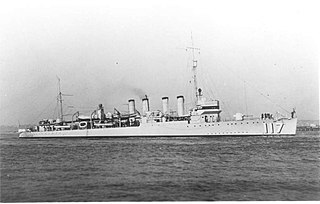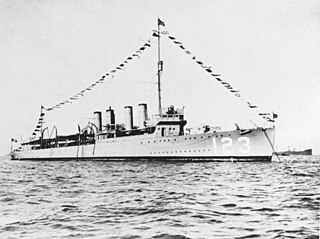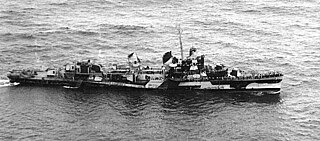
USS Arnold J. Isbell (DD-869), a Gearing-class destroyer, was the only ship of the United States Navy to be named for Arnold J. Isbell, an aircraft carrier captain during World War II. The ship was laid down on 14 March 1945 at Staten Island, New York, by Bethlehem Mariners Harbor, launched on 6 August 1945 and commissioned on 5 January 1946. Constructed too late to see action in World War II, the vessel initially served as a training ship with the United States Atlantic Fleet, before transferring to the Pacific and deploying to Korea during the Korean War and off the Vietnam coast during the Vietnam War. In 1972 Arnold J. Isbell was made part of the reserve training fleet and in 1974, sold to Greece where the ship was renamed Satchouris and served with the Hellenic Navy until being sold for scrap in 2002.

The third USS Farragut (DD-348) was named for Admiral David Glasgow Farragut (1801–1870). She was the lead ship of her class of destroyers in the United States Navy.

USS Lamberton (DD-119)/(DMS-2) was a Wickes-class destroyer in the United States Navy in commission from 1918 to 1922 and from 1930 to 1946. She saw service during World War II. She was the only ship named for Benjamin P. Lamberton, a rear admiral who served with Admiral Dewey in the Battle of Manila Bay in 1898 during the Spanish–American War.

The first USS Philip (DD–76) was a Wickes-class destroyer in the United States Navy during World War I, later transferred to the Royal Navy as HMS Lancaster. She was named for John Woodward Philip.

USS Vammen (DE-644) was a Buckley-class destroyer escort of the United States Navy.

USS Dorsey (DD–117), reclassified DMS-1 on 19 November 1940, was a Wickes-class destroyer in the United States Navy during World War I. She was named for John Dorsey.

USS Gamble (DD–123/DM-15) was a Wickes-class destroyer in the United States Navy during World War I, later converted to a minelayer in World War II.

USS Ramsay (DD-124) was a Wickes-class destroyer in the United States Navy during World War I, reclassified as DM-16 during World War II and again reclassified as AG-98. She was the first ship named for Rear Admiral Francis Ramsay.

USS Stansbury (DD–180) was a Wickes-class destroyer in the United States Navy during World War II.

USS Haraden (DD-585), a Fletcher-class destroyer, was the second ship of the United States Navy to be named for Jonathan Haraden (1744–1803), a privateer of the American Revolutionary War.

USS Fox (DD-234/AG-85) was a Clemson-class destroyer in the United States Navy during World War II. She was the fourth ship named for Gustavus Vasa Fox, Assistant Secretary of the Navy during the Civil War.

USS Williamson (DD-244/AVP-15/AVD-2/APD-27) was a Clemson-class destroyer in the United States Navy during World War II. She was named for Commander William Price Williamson.

USS Goff (DD-247) was a United States Navy Clemson-class destroyer in commission from 1921 to 1931 and from 1932 to 1945. She saw service during the Second Nicaraguan Campaign and World War II. She was named for Secretary of the Navy Nathan Goff, Jr.

USS Hudson (DD-475), a Fletcher-class destroyer, was the second ship of the United States Navy to be named for Captain William L. Hudson (1794–1862).

USS Terry (DD-513), a Fletcher-class destroyer, was the second ship of the United States Navy to be named for Commander Edward A. Terry (1839–1882).

USS Stoddert (DD-302/AG-18) was a Clemson-class destroyer in the United States Navy following World War I. She was named for Benjamin Stoddert.

USS Sicard (DD-346/DM-21/AG-100) was a United States Navy Clemson-class destroyer in commission from 1920 to 1945. She was service during World War II. She was named for Rear Admiral Montgomery Sicard.

The third USS Macdonough (DD-351) was a Farragut-class destroyer in the United States Navy during World War II. She was named for Thomas Macdonough.

USS Whitehurst (DE-634), a Buckley-class destroyer escort of the United States Navy, was named in honor of Ensign Henry Purefoy Whitehurst, Jr., a crew member of the Astoria (CA-34) who was killed during the Battle of Savo Island in August 1942.

USS Brackett (DE-41) was an Evarts-class destroyer escort of the United States Navy during World War II. She was sent off into the Pacific Ocean to protect convoys and other ships from Japanese submarines and fighter aircraft. She performed escort and anti-submarine operations in dangerous battle areas and was awarded three battle stars.





















